#extinct bird
Text
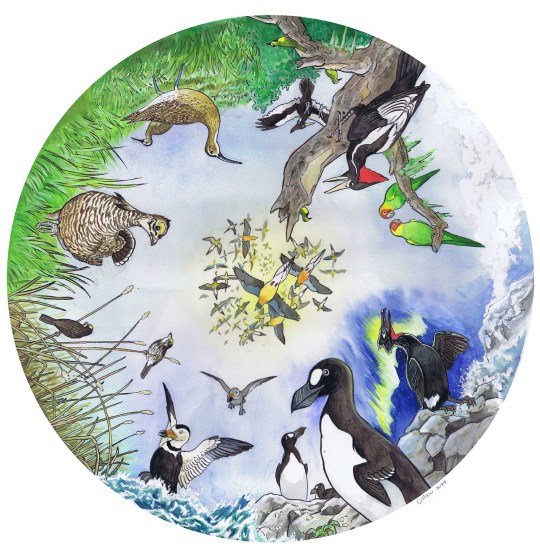
Lost Americans wheel. Watercolor and ink.
#extinct#extinct bird#great auk#carolina parakeet#passenger pigeon#eskimo curlew#labrador duck#ivory billed woodpecker#bachman's warbler#heath hen#dusky seaside sparrow#spectacled cormorant
816 notes
·
View notes
Text

The massive mother Devincenzia, one of the biggest terror birds to ever walk the earth, looked dissaprovingly at what was before her, with a piercing gaze coming from her eyes, over two metres off the forest floor. She was not amused, to put it mildly.
Her two chicks had hatched recently, and had proven themselves to be quite a wingful. They were always up to no good, chasing small animals, running over logs, and getting into mischief. Now, they had been running around a clearing, which had a strange thing among a huge pile of leaves.
The Devincenzia was naturally suspicious of strange objects, and the strange black box that was among the leaves. Occasionally it made a clicking sound. The terror bird didn’t know what it was. As far as she was concerned, it may have been a strange vine. But she didn’t like it. She decided to lead her little rascals elsewhere.
#paleoart#palaeoblr#stylized paleoart#terror bird#devincenzia#miocene#palaeo cartoon#birblr#bird art#extinct bird
520 notes
·
View notes
Text


Relatively brief post because I imagine people won't care much about this one (nor is there that much to talk about). But newly described from the Pliocene of New Zealand we have Macronectes tinae, which we might as well call Tina's Giant Petrel.
Known from a really well preserved skull and a partial humerus, Tina's Giant Petrel is a species of giant petrel, but notably smaller and less robust than the modern species, like these ones.

There might be two reasons why its smaller. One is simple really. Giant petrels stand out amongst their relatives for being ridiculously big, while all their closest kin are pretty small. So logically, an older, more basal giant petrel is expected to be smaller. The authors also speculate that living in warmer waters is another factor, but modern petrel ranges are huge so that hypothesis is less solid.
Even if it was smaller, Tina's Giant Petrel still lived a life that was likely similar to its modern relatives. Meaning it was an absolute beast of a bird. Modern petrels are well known to scavenge near seal colonies and penguing colonies, mob other birds, steal and eat the chicks of other sea birds and also hunt for fish, squid and crustaceans. Google "giant petrel" and expect to be greeted by birds either absolutely tearing apart carcasses or being covered in blood. Petrels look pretty metal. As it so happens, Tina's Giant Petrel was found in a formation that is in no short supply of potential prey.
Eomonachus, a monk seal (illustrated by seal king Jaime Bran), Eudyptes atatu, a penguin (illustrated by Simone Giovanardi), Aldiomedes angustirostris, an albatross, various petrels and an undescribed species of pseudo-tooth bird (skull illustration by Jaime Headden) all would have given the extinct petrel a lot of options.


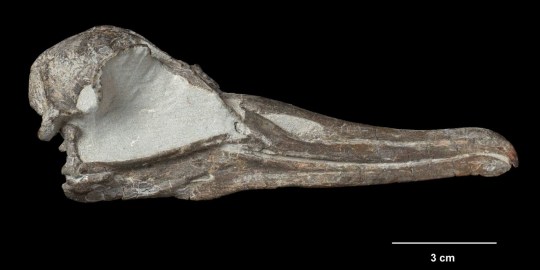
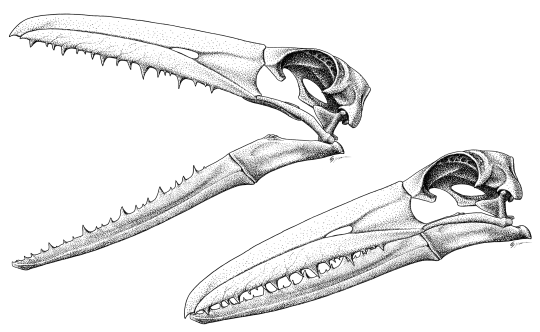
The paper also provides an illustration of the bird itself. Notably the artist, Simone Giovanardi who previously illustrated the penguins up above, decided to give this species darker plumage, reasoning that petrels in warmer waters tend to be darker than their relatives in the colder waters further south. The illustration shows it feeding on the carcass of a seal, probably the local Eomonachus.

Link to the paper: Taxonomy | Free Full-Text | A New Giant Petrel (Macronectes, Aves: Procellariidae) from the Pliocene of Taranaki, New Zealand (mdpi.com)
And obligatory link to Wikipedia: Macronectes tinae - Wikipedia
#giant petrel#paleontology#macronectes tinae#seabird#new zealand#palaeblr#technically dinosaur#bird#petrel#extinct bird#pliocene#Tangahoe Formation
55 notes
·
View notes
Text
youtube
Such a sad truth. The Kauaʻi ʻōʻō was a bird in Hawaii that was declared endangered in 1973. The last breeding pair lost its female, and the last male died in 1987. When somebody recorded the last male’s mating song, they purportedly played it back, and the bird is said to have turned around, briefly thinking another existed still. They had mated for life and had a lovely song. And it was the last of not only its species but its entire family.
#Youtube#Kauai o’o#sad#sad film#tearjerker#extinct animal#extinct species#extinct animals#film#short#short film#bird#extinct bird#extinct birds#art#extinct#extinction
8 notes
·
View notes
Text

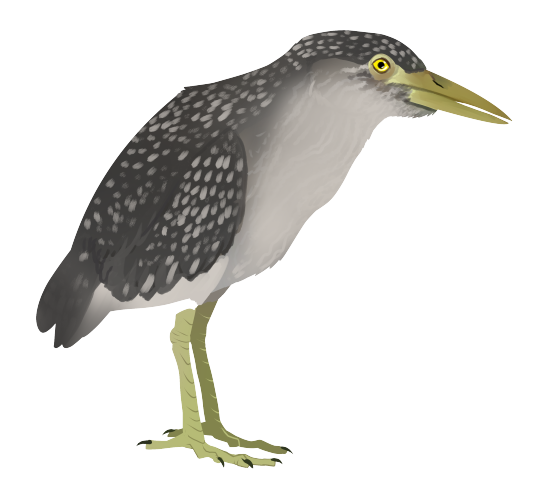
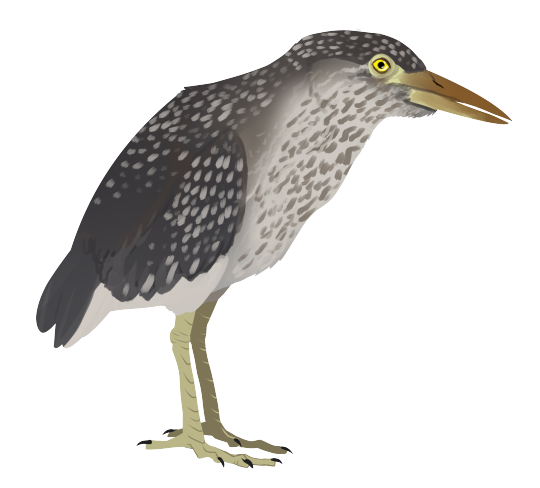
Don't feel like doing a write up for these ones this time!
Mauritius Night-heron
Réunion night heron
Rodrigues Night-heron
Check out my Carrd on my pinned post for how you can support me
15 notes
·
View notes
Text
A study that just came out demonstrates that outdoor cats are known to prey on over two thousands species of wild animal, from mammals to birds to insects. That includes 347 species that are endangered, threatened or otherwise of concern, and they've been a key factor of the permanent extinction of over 60 species. And while cats may not always bring home what they catch, chances are if your cat is allowed to roam unsupervised outside, they're killing your local wildlife.
Why is this so important? Worldwide, wild animal populations have decreased in number by 69% in the past fifty years; that means that in my lifetime (born in 1978), the sheer number of wild animals in the world has been decreased by over half. Even "common" wild species are less numerous than before. While habitat population is the single biggest cause of species endangerment and extinction overall, outdoor and indoor/outdoor cats are a significant cause as well. In fact, they are the single biggest cause of human-caused mortality in wild birds.
Most importantly, it's very, very simple to fix this problem: keep your cats indoors, and spay and neuter them. If your cat is bored, they need more enrichment, and there are plenty of ways to make your home more exciting for them, from bringing home cardboard boxes for them to explore, to playing with them more often. If you want your cat to get some outdoor enrichment, leash train them (yes, it can be done!) If you have the space and resources, build them a catio where they can be safe from outdoor dangers like predators and cars, while also keeping local wildlife safe from them.
If you just give into their whining and pawing at the door, then they know that that's what they have to do to get their way; I know it's a tough transition, but it's worth it in the end for everyone involved. Cats are domesticated, which means they are not native anywhere in the world; there are exactly zero ecosystems in which they belong, save for the safety of your home. It is your responsibility to give them an enriching environment without taking the shortcut of letting them go wreak havoc outside.
#cats#outdoor cats#feral cats#nature#wildlife#animals#ecology#environment#conservation#science#scicomm#birds#endangered species#extinction#domesticated animals#domestication#biology#animal behavior#animal welfare
8K notes
·
View notes
Text
0 notes
Text

leave everything always unbroken
1K notes
·
View notes
Text

Sunlemon - LOST ANIMALS
#plush#plushie#plushies#plushblr#plushcore#toycore#soft toy#stuffed animals#sunlemon#lost animals#extinct animals#mammoth#steller's sea cow#dodo#japanese wolf#great auk#plush: prehistoric#plush: pachyderm#marine mammals#plush: bird#plush: wolf#plush: canine
1K notes
·
View notes
Text

Tie a string around your finger, so you won't forget...
The Carolina Parakeet was declared extinct in 1939.
Up until just the year before, people were still claiming to have sighted the yellow-headed parakeets in the wild—in the impenetrable depths of Georgia's Okefenokee Swamp; along the Santee River basin of South Carolina, where people still search for the Ivory-Billed Woodpecker to this day—but evidence suggested only escaped, feral species of pet birds, tinged by wishful thinking.
The last definitively identified specimen of Conuropsis carolinensis, a male named Incas, had died at the Cincinnati Zoo in 1918. As it happens, his last home was the very same cage in which Martha, the endling Passenger Pigeon, had spent her final years. 2014, the hundredth anniversary of Martha's loss, brought the publication of a number of new books on the topic of the Passenger Pigeon and even a documentary; the centenary of Incas' death, by contrast, warranted only a handful of mentions of our lost native parrot.
Hardly a hundred years later, our parakeet has faded from common memory—like the fading text on the tags that twine around the feet of the study skins that fill museum specimen drawers, where they should have filled the sky, should have filled roosts in hollow trees, should have filled our backyards; should have filled their lungs with air, and our hearts and imaginations and eyes with the sight of their iridescent green feathers.
The title of this painting is Memory Knot. It is gouache on 18 x 13 inch paper, and is the 9th piece in my series on the extinct Carolina Parakeet. It is also the final piece in the series as originally conceived (though inspiration continues to strike, and this is not the last appearance the species will make in my art).
Please, remember that there was a bird called the Carolina Parakeet. Remember what happened to it. Remember that we are the only ones who can keep it from happening again.
992 notes
·
View notes
Text
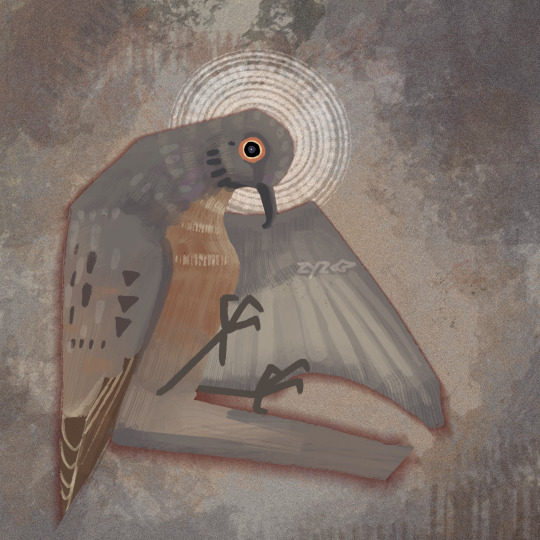
Its 2024!!! Happy new year, or happy new year's eve depending on where in the world you are.
And a great time to begin a new art challenge. I have a list of extinct birds for january, starting (ofc) with the passenger pigeon. These are such a great representative species for extinct birds imo - they used to be one of the most numerous birds on Earth, numbering in the billions, yet they vanished within a century. So gorgeous too!
As a communally roosting bird, their sheer numbers used to snap even large branches and they often piled on top of each other to roost. And then. Poof. None left.
#artists on tumblr#birds#pigeon#digital art#extinct animals#digital illustration#birdblr#bird art#bird of the day#passenger pigeon#columbiformes
1K notes
·
View notes
Text
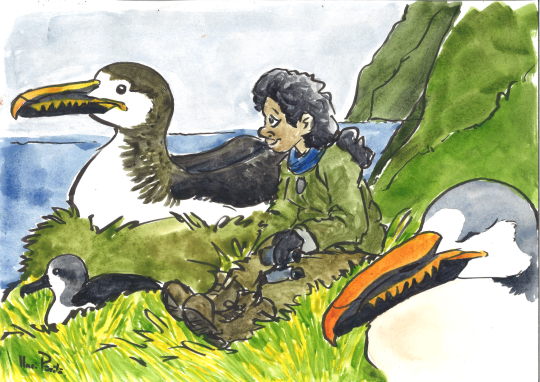
The traveller gazed upon the vastness. She listened to the sounds of ocean surf and the peculiar chorus of seabirds. It had been a long day. She needed a rest.
The creatures around her barely took note by her. They didn’t know what she was. If she wasn’t something they knew was dangerous, why bother? So the pelagorns, small early albatrosses and others went about their day as usual, curious yet ignorant of the traveller from a distant place.
The traveller smiled. It was a tough trip to travel here. To the Pliocene, to the Antarctic sea. To see the world as it once was. And view life before her time. And here, on this island by a roaring sea, she was at peace. A part of her never wanted to leave.
#paleoart#palaeoblr#birblr#Pelagornis#albatross#stylized paleoart#palaeo cartoon#extinct bird#watercolor#pliocene
438 notes
·
View notes
Text

Feel like shit just want them back
#I'm not even joking i think about them on average at least once a day#i am unwell#passenger pigeon#we did you so so wrong#it's Makenna Is Mad About Extinct Birds hour again#martha i will avenge you#i don't know how yet but I'll do it#shut up me#extinction#extinct animals#birds#birdblr#environmentalism#i want to see them block out the sun i want to witness their splendor#but i can't and my soul will never know peace
766 notes
·
View notes
Text
So, I saw a post circulating here about the “extinction of birds in 2023“, with this picture attached
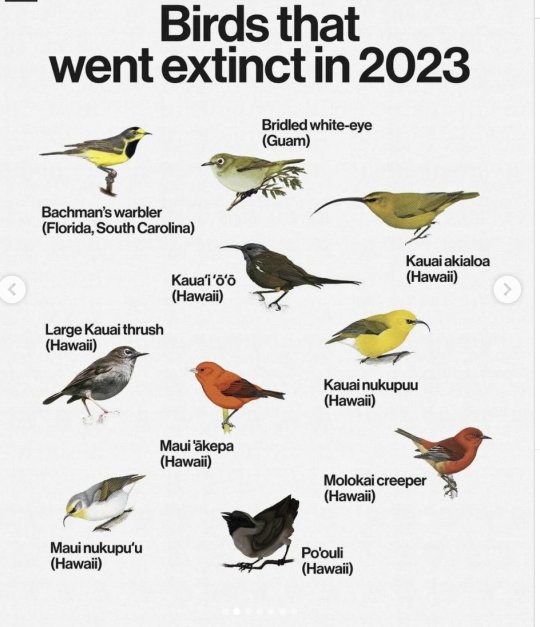
My, what a bold claim! All these poor birdies, “went extinct” in just one year alone? Why would such an outrageous, depressing and catchy claim be spread around?
Let’s fact check it.
All the species listed, Bachman’s wabler (Vermivora bachmanii, 1988 or 1980s), Kāmaʻo or large Kauaʻi thrush (Myadestes myadestinus, 1989 or 1987), Bridled white-eye (Zosterops conspicillatus, 1983 and 1983), Kauai ʻakialoa (Akialoa stejnegeri, 1969 or 1960s), Kauaʻi ʻōʻō (Moho braccatus, 1987 and 1987), Kauaʻi nukupuʻu (Hemignathus hanapepe, 1899 and 1899), Maui ʻakepa (Loxops ochraceus, 1988 and 1988), Kākāwahie or Molokaʻi creeper (Paroreomyza flammea, 1963 and 1963), Maui nukupuʻu (Hemignathus affinis, 1896* and 1996 ) and Poʻouli (Melamprosops phaeosoma, 2004 and 2004) are all, indeed, either extinct or possibly extinct, according to IUCN Red List of Threatened Species and U.S. Fish and Wildlife Service.
What are the dates after the scientific names? Well, those all are *last sightings* per IUCN Red List and USFWS accordingly. So, these birds were not seen for DECADES and in one case FOR MORE THAN A GODDAMN CENTURY. And sure as hell there is NO information about them very suddenly being gone all last year.
What’s the deal then? Where did this claim even come from? Well, likely from this article "21 Species Delisted from the Endangered Species Act due to Extinction" from U.S. Fish & Wildlife Service. It includes all the birds in the picture (with the last date of sight, listed above).
From the article: “The U.S. Fish and Wildlife Service is delisting 21 species from the Endangered Species Act due to extinction. Based on rigorous reviews of the best available science for each of these species, the Service determined these species are extinct and should be removed from the list of species protected under the ESA. Most of these species were listed under the ESA in the 1970s and 80s and were in very low numbers or likely already extinct at the time of listing.”
They didn’t ALL fucking suddenly drop dead all in the same year – if they did, as some other people have already pointed out, there would be an uproar EVERYWHERE. Ornithologists alone would not let it live down. They were officially delisted from endangered status by U.S. Fish & Wildlife Service that year, there was a proposition to do so back in 2021, too. Some were already declared extinct before by IUCN.
Despite not being seen for so long, they remained on the list of critically endangered for a long while, cause you cannot just immediately declare a species extinct. There’s no RTS unit amount number that goes to 0 once there’s nothing left; people keep checking for them over and over and over again. Sometimes it turns out that a species previously thought to be extinct is actually still out there. Attenborough's long-beaked echidna for example was last sighted SIXTY YEARS ago before being sighted again in 2023. It was thought to be extinct for a while, before 2007, when signs of its activity was spotted again. More often than not though, a species turns out to be actually very extinct, unfortunately – like in this case.
I cannot possibly know if the creators of this picture, or people that spread it on social media ever had good intentions behind it for awareness, however even if they did, it turned out to be nothing but very blatant misinformation, with a fearmongering effect. The only thing this achieves is not awareness of habitat destruction or pernicious tourist influence or climate change or what have you – the only thing this achieves is despair and panic. People already so casually fall into complete doomerism, they’re very used to hear bad news. And guess what doomerists do? Typically nothing. It renders people helpless. It’s not gonna make people get up and be ready for action, it, at best, would just make people feel sad and/or angry, or at worst, feed into the current alarming rise of ecofascism. NOTHING good comes out of this. At the very goddamn least, no one needs to lie to promote a goal.
The aim of the USFWS article, on the other hand, IS to make people aware about those animals that are already gone from the face of the planet, no matter how long ago, and that now we have to protect those animals that are critically endangered and still out there – to not have to repeat those tragedies.
Be very critical of what you see on the internet, especially if it’s sited with no sources. Especially-especially if it causes a strong emotional reaction. Lies and misinfo could only hurt the cause, no matter how noble. And please, be aware of your local wildlife status. Check in with it accoding to trusted sources.
[*sic, possibly a typo and it was meant to be 1996, other confirmed date listed there is 1989]
Addendum: I could not for sure find the uncredided (who woulda thunken that ppl that don't cite their sources would also not credit the artists) author(s) of the bird illustrations. If someone finds them, please, let me know!
Edit: Huge thanks to moosefinch for finding the sources for the artwork! I'll add their contribution below:
"Image sources!
The Kauai ʻakialoa, Kauaʻi ʻōʻō, Maui ʻakepa and Kauaʻi nukupuʻu are from Birds of the World.
The "Maui nukupuʻu" and "Molokaʻi creeper" illustrations are also Birds of the World, but are actually a female Kauaʻi nukupuʻu (the other being the male) and Laysan honeycreeper/Laysan ʻapapane respectively.
The bridled white-eye is by Lauren Helton according to this source.
Bachman's warbler is by Lynn Hawkinson Smith/smithhouse2 according to this Etsy listing.
The Poʻouli is by Christina Czajkowski."
#ah I just now see that the tumblr reblog of the pic and the twitter thread attached was deleted#yet the post is still in circulation. The damage lingers#so fucking irresponsible#fact check#misinformation#birds#bird#ecology#environmentalism#extinction#conservation#species conservation#animals#hawaiʻi#important
807 notes
·
View notes
Video
‘Lost’ pigeon found after more than a century
A September expedition to Papua New Guinea confirmed via video the existence of the black-naped pheasant pigeon, a critically endangered species that has not been reported for 140 years.
“For much of the trip, it seemed like we had no chance of finding this bird,” said Jordan Boersma, co-leader of the expedition and a postdoctoral researcher at the Cornell Lab of Ornithology. “We were just two days away from the end of our time on Fergusson Island in Papua New Guinea when one of our remote cameras recorded the bird walking around and fanning its tail.”
The group captured the first-ever video and still photos of the bird, a large ground-dwelling species with a rust-colored back, a black head and body, and a bobbing pheasant-like tail. It may only exist far inland on Fergusson Island in hot, extremely rugged geothermal terrain laced with twisty rivers and dense with biting insects and leeches...
Read more: https://news.cornell.edu/stories/2022/11/lost-pigeon-found-after-more-century
5K notes
·
View notes
Text

a dopping of Malagasy shelduck roost in holocene Madagascar. these birds are closely related to the extant Egyptian goose, which were my main reference for the markings.
this was drawn during Paleostream, it was great to finally catch one and I hope to make it a recurring thing :)
#fraizer draws#art#paleostream#paleoart#palaeoart#malagasy shelduck#shelduck#alopochen sirabensis#illustration#birds#extinct birds#sirabe shelduck
523 notes
·
View notes